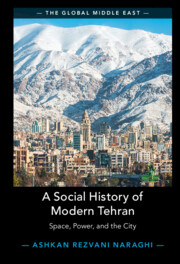Book contents
- A Social History of Modern Tehran
- The Global Middle East
- A Social History of Modern Tehran
- Copyright page
- Dedication
- Contents
- Figures
- Tables
- Foreword
- Preface
- Introduction
- 1 Segmented Society and the Social Production of Communal Spaces
- 2 Segmented Society and Spaces of Political Mobilization
- 3 Iranian Travelers and the Production of Spatial Knowledge
- 4 The Qajar Court and the City
- 5 The Interwar Period and Middle-Class Urbanism
- 6 The Age of Social Movements
- Conclusion
- Appendix Protest, Political Gatherings, and Parades between 1941 and 1953
- Bibliography
- Index
4 - The Qajar Court and the City
Spatial Strategies of the State in the Nineteenth Century
Published online by Cambridge University Press: 22 December 2022
- A Social History of Modern Tehran
- The Global Middle East
- A Social History of Modern Tehran
- Copyright page
- Dedication
- Contents
- Figures
- Tables
- Foreword
- Preface
- Introduction
- 1 Segmented Society and the Social Production of Communal Spaces
- 2 Segmented Society and Spaces of Political Mobilization
- 3 Iranian Travelers and the Production of Spatial Knowledge
- 4 The Qajar Court and the City
- 5 The Interwar Period and Middle-Class Urbanism
- 6 The Age of Social Movements
- Conclusion
- Appendix Protest, Political Gatherings, and Parades between 1941 and 1953
- Bibliography
- Index
Summary
The 1870s expansion of Tehran was a vehicle for the spatial commodification of vast sections of the new city. Through this expansion, the Qajar court managed to produce the new spatiality as a lucrative commodity. The commodification of the city accompanied an unprecedented socio-spatial bureaucratization. A combination of several factors –from preventing outbreaks of diseases to organizing a novel relationship between the state and society – helped the state to stretch its control and dominance over the spatiality of the city. In its initial steps, these early attempts were the manifestations of a fundamental shift in the relationship between the state, society, and the city. To use Lefebvre’s concept of abstract spaces, Tehran went through a process of spatial abstraction particularly after its 1870s expansion. This chapter demonstrates how this expansion followed delicate economic objectives, and how the Qajar court had pursued this commodification process through its spatial policies long before the actual expansion of Tehran. Afterwards, the chapter focuses on the bureaucratization process and argues that, from the first half of the nineteenth century, the state had already generated spatial strategies to prevent cholera outbreaks in the city. The chapter moves to the examination of the spatial strategies of the state for the legitimation of its power and demonstrates how the expansion of Tehran helped the state to stretch its spatial control and domination beyond the confines of the royal compound. It continues with the study of the social life and spaces of the new neighborhood at the end of the nineteenth century and finds that the Qajar elites produced semi-private spaces modeled after European social space. Finally, the chapter concludes with the investigation of the spatial strategies of the state and the impact of the two processes of commodification and bureaucratization on Tehran.
- Type
- Chapter
- Information
- A Social History of Modern TehranSpace, Power, and the City, pp. 174 - 232Publisher: Cambridge University PressPrint publication year: 2023

